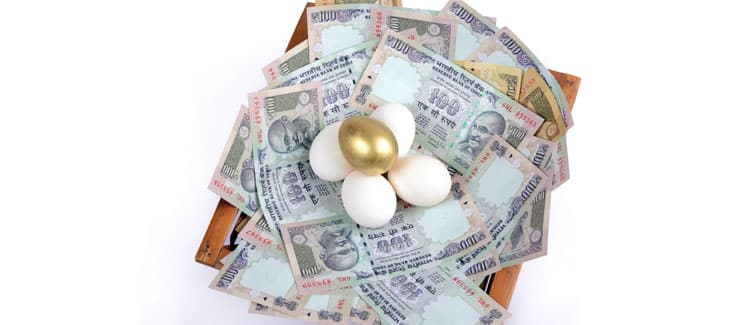Cost Inflation Index
The Cost Inflation Index (CII) is a tool used in India to adjust the purchase price of an asset for inflation. This is important because inflation can significantly impact the cost of an asset over time.
What is the Cost Inflation Index?
The Cost Inflation Index (CII) is a tool used to calculate long-term capital gains from the sale or transfer of capital assets like property, stocks, trademarks, and patents. Since these assets are recorded at their cost price in books, their value doesn't increase with market prices over time. When these assets are sold, the profit appears high due to their increased sale price compared to their acquisition price, leading to higher tax payments. However, applying the CII adjusts the asset's purchase price based on inflation, resulting in smaller gains and lower tax amounts in the long run.
Cost Inflation Index Formula = 75% average increase in CPI (Consumer Price Index) for the immediate previous year
Cost Inflation Index Table from FY 2001-02 to FY 2023-24
| Financial Year | Cost Inflation Index (CII) |
| 2001-02 (Base year) | 100 |
| 2002-03 | 105 |
| 2003-04 | 109 |
| 2004-05 | 113 |
| 2005-06 | 117 |
| 2006-07 | 122 |
| 2007-08 | 129 |
| 2008-09 | 137 |
| 2009-10 | 148 |
| 2010-11 | 167 |
| 2011-12 | 184 |
| 2012-13 | 200 |
| 2013-14 | 220 |
| 2014-15 | 240 |
| 2015-16 | 254 |
| 2016-17 | 264 |
| 2017-18 | 272 |
| 2018-19 | 280 |
| 2019-20 | 289 |
| 2020-21 | 301 |
| 2021-22 | 317 |
| 2022-23 | 331 |
| 2023-24 | 348 |
Cost Inflation Index in Income Tax
-
Long-term capital assets are recorded at their original cost in books, not reflecting inflation over time.
-
Upon sale, the higher selling price compared to the purchase price can inflate apparent profits, leading to higher income tax liabilities.
-
The Cost Inflation Index (CII) is applied to long-term capital assets to adjust their purchase cost for inflation.
-
This adjustment reduces taxable profits, resulting in lower income tax liabilities for taxpayers.
-
The CII benefits taxpayers by aligning long-term asset purchase costs with inflation, easing their tax burden.
Concept of the Base Year in Cost Inflation Index
The base year in the Cost Inflation Index (CII) marks the starting point with an index value of 100. Subsequent years' indices are compared to this base year to compare inflation percentage. Assets acquired prior to this base year benefit from indexation applied to either the actual cost or Fair Market Value (FMV) as of the base year's first day, determined through a registered valuer's report.
Reason Why Cost Inflation Index is Calculated
The Cost Inflation Index (CII) is calculated to adjust for the effects of inflation on prices over time. As inflation rates increase, so do prices. The CII helps maintain a fair comparison of prices by factoring in this inflation. This index is important for various financial and tax-related calculations, ensuring accuracy and fairness in economic assessments.
Why Did the Base Year of Cost Inflation Index Change in 2001 from 1981?
The change in the base year of the Cost Inflation Index (CII) from 1981 to 2001 in 2001 aimed to alleviate challenges faced by taxpayers and tax authorities. Before this change, valuing properties bought before April 1, 1981, was cumbersome. Taxpayers and authorities struggled with accurate valuation, prompting the shift to 2001. This change allowed for quicker and more reliable valuations, enabling taxpayers to benefit from indexation by considering either the actual cost or the Fair Market Value (FMV) as of April 1, 2001, for assets bought before that date.
For Indexation of Long-Term Capital Assets
To calculate the indexed cost of asset acquisition,
Indexed Cost of Asset Acquisition = (CII at the time asset was sold X Cost of Acquisition) / CII at the time asset is possessed
To calculate the indexed cost of asset improvement,
Indexed Cost of Asset Improvement = CII at the time the asset was sold X Cost of Asset Improvement) / CCI at the time improvement is made
Points to Consider
-
Property Inheritance: For properties received through a will, the Cost Inflation Index (CII) is determined based on the year of receipt, not the original purchase year.
-
Exclusion of Pre-2001 Improvements: Improvement costs incurred before 1st April 2001 are disregarded when calculating CII for property.
-
No Index Benefit for Bonds: Bonds or debentures, except for certain types like capital indexation bonds or sovereign gold bonds issued by the RBI, do not qualify for indexation benefits.
-
Change in Debt Fund Indexation: As of 1st April 2023, debt funds no longer enjoy indexation benefits, affecting their tax calculations.
Practical Examples
Scenario 1: Property Sale (Indexed Cost of Acquisition):
Rohit bought a flat in 2001-02 for Rs. 10,00,000 and sold it in 2017-18. The CII for these years were 100 and 272, respectively. Using CII, the indexed cost of acquisition was calculated as Rs. 27,20,000. This indexed cost helps in determining the capital gains tax liability more accurately by adjusting for inflation.
Scenario 2: Capital Asset Sale (Pre-Base Year Purchase):
Rhythm purchased a capital asset before the base year (FY 1995-96) for Rs. 2,00,000, and its fair market value (FMV) in 2001-02 was Rs. 3,20,000. When she sold it in 2016-17, the indexed cost of acquisition was determined by using the CII for these years (100 and 264). The indexed cost was calculated as Rs. 8,44,800, providing a fair valuation for taxation purposes.
Scenario 3: Equity Shares Sale (Indexed Cost Calculation):
Kaneeka bought equity shares worth Rs. 1,00,000 in FY 2014-15 and sold them in FY 2020-21. With the CII of 240 and 301 for these years, the indexed cost of acquisition was computed as Rs. 1,25,416. This adjusted cost helps in accurately calculating the capital gains tax on the sale of equity shares.
Scenario 4: Sovereign Gold Bonds Redemption (Indexed Cost Calculation):
Akshat invested in Sovereign Gold Bonds (SGB) in FY 2015-16 for Rs. 2,00,000 and redeemed them prematurely in FY 2020-21 at the market price of Rs. 2,55,000. Using the CII of 254 and 301 for these years, the indexed cost of acquisition was determined as Rs. 2,37,007. This indexed value aids in computing the capital gains or losses accurately when redeeming bonds prematurely.
Conclusion
The Cost Inflation Index (CII) serves as a valuable tool for taxpayers in India. By accounting for inflation's impact on asset prices, the CII ensures fairer taxation on capital gains. This can result in significant tax savings, particularly when dealing with long-term investments. If you're planning to sell a capital asset in India, understanding and using the CII can be beneficial for optimizing your tax liability.
FAQs
-
Does applying the CII reduce tax liability?
Yes, applying the Cost Inflation Index significantly reduces tax liability. It revalues long-term capital assets according to the CII of the respective year, resulting in reduced profits upon asset sale and, consequently lower tax liability. -
What's the purpose of applying the Cost Inflation Index?
The purpose of applying the Cost Inflation Index is to adjust the purchase price of assets based on their sale price. This adjustment helps in reducing profits and subsequently lowering the tax liability. -
What's the formula used to calculate indexation cost?
The formula for calculating indexation cost is ((Index for the year of sale) / (Index for the year of purchase)) x cost.
˜The insurers/plans mentioned are arranged in order of highest to lowest first year premium (sum of individual single premium and individual non-single premium) offered by Policybazaar’s insurer partners offering life insurance investment plans on our platform, as per ‘first year premium of life insurers as at 31.03.2025 report’ published by IRDAI. Policybazaar does not endorse, rate or recommend any particular insurer or insurance product offered by any insurer. For complete list of insurers in India refer to the IRDAI website www.irdai.gov.in
*All savings are provided by the insurer as per the IRDAI approved insurance plan.
^The tax benefits under Section 80C allow a deduction of up to ₹1.5 lakhs from the taxable income per year and 10(10D) tax benefits are for investments made up to ₹2.5 Lakhs/ year for policies bought after 1 Feb 2021. Tax benefits and savings are subject to changes in tax laws.
¶Long-term capital gains (LTCG) tax (12.5%) is exempted on annual premiums up to 2.5 lacs.
++Source - Google Review Rating available on:- http://bit.ly/3J20bXZ


- SIP Calculator
- Income Tax Calculator
- Compound Interest Calculator
- NPS Calculator
- Show More Calculator
Income Tax articles
Explore the popular searches and stay informed
- LIC
- Investment Plan
- Annuity Plan
- Child Plan
- Pension Plan
- ULIP Plan
- Child Investment Plan
- SIP
- LIC Calculator
- SIP Calculator
- SBI SIP
- ULIP Calculator
- Sukanya Samriddhi Yojana
- Best SIP Plans
- Retirement Planning
- SBI SIP Calculator
- HDFC SIP Calculator
- Sukanya Samriddhi Yojana Interest Rate
- NPS Interest Rate
- Deferred Annuity Plans
- SBI Annuity Deposit Scheme Calculator
- Immediate Annuity Plans
- Post Office Child Plan
- Prime Minister Schemes For Boy Child
- Government Schemes for Girl Child
- 50k Pension Per Month
- Atal Pension Yojana Calculator
- Best Pension Plan in India
- CIBIL Score
- 1 Crore Term Insurance
- Best Term Insurance Plan
- Term Insurance for Women
- Term Insurance for NRI
- Term Insurance
- Term Insurance Calculator
- Life Insurance
- Term Insurance with Return of Premium
- Whole Life Insurance
- Term Insurance vs Life Insurance
- What is Term Insurance
- Life Insurance Calculator
- 5 Crore Term Insurance
- 2 Crore Term Insurance
- 50 Lakh Term Insurance
- Term Insurance for Housewife
- Benefits of Term Insurance
- Term Insurance Terminology
- Medical Tests for Term Insurance
- Term Insurance for Self Employed
- Claim Settlement Ratio
- 10 Crore Term Insurance
- Term Insurance for Smokers
- 1.5 Crore Term Insurance
- Zero Cost Term Insurance
- FIRE Calculator

















